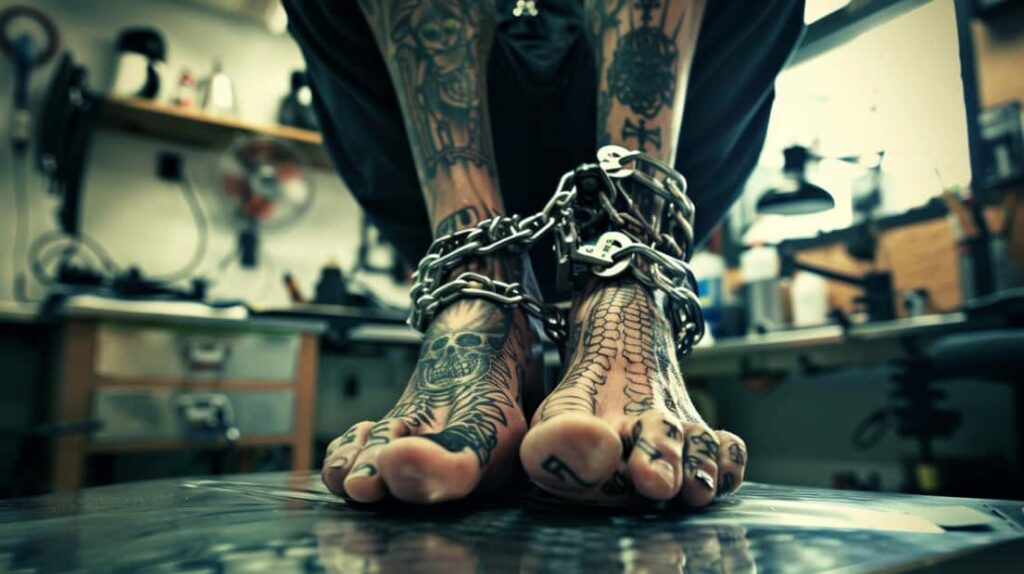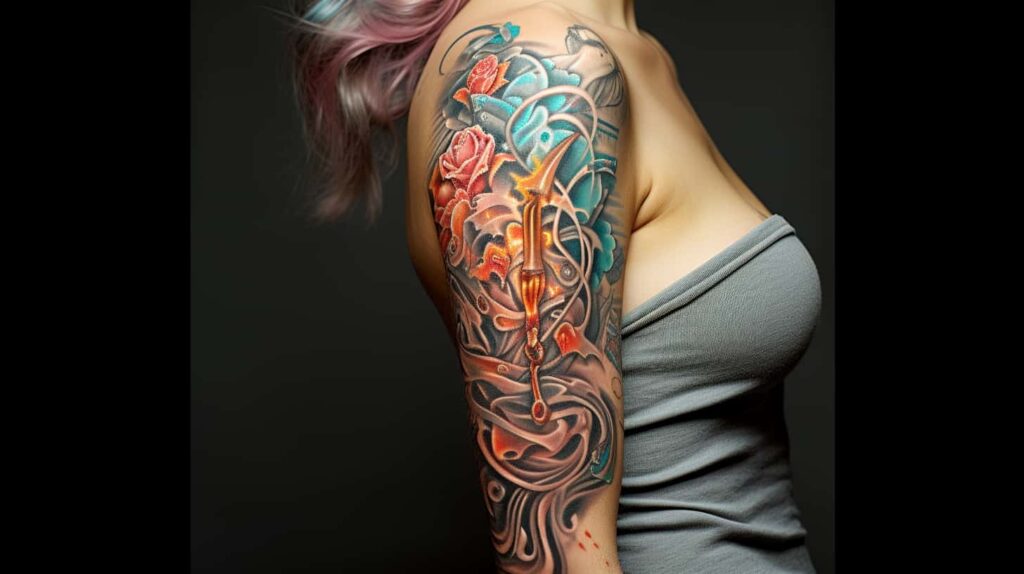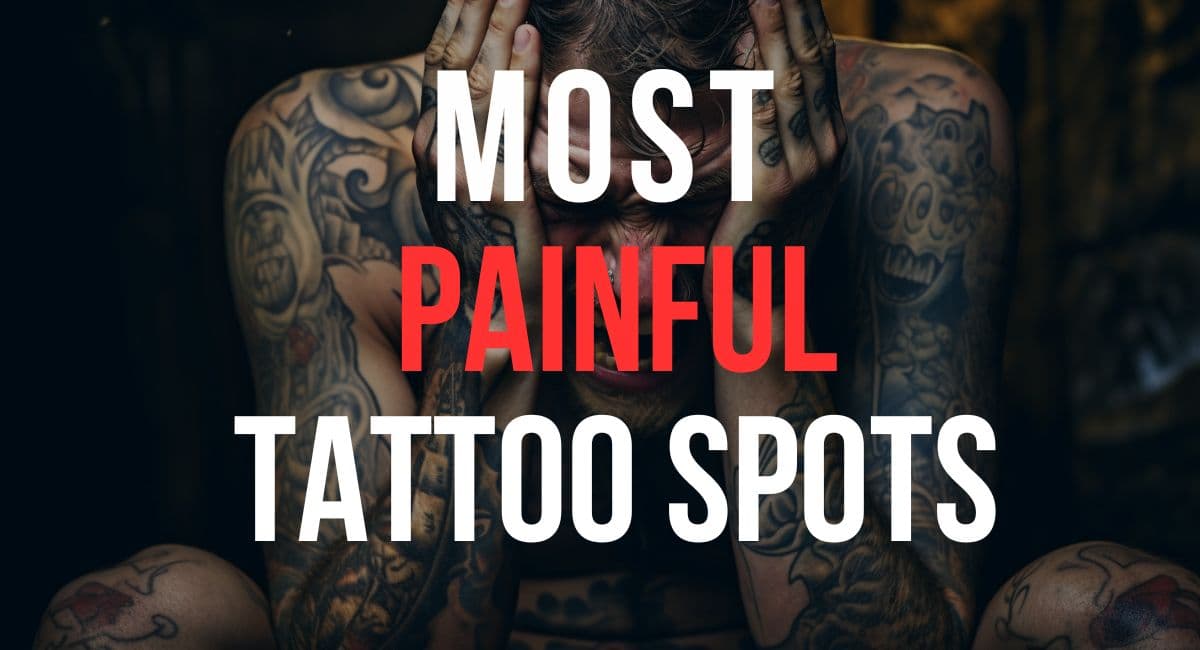According to tattoo artists and anecdotal evidence, certain body areas tend to be more painful to tattoo. Spots can appear in many areas, like the armpit, rib cage, and stomach. They can also appear on the collarbone, elbows, knees, shins, ankles, and feet. Other places include the middle of the chest, face, inner thighs, head, groin, hands, buttocks, and neck and spine. The amount of pain from a tattoo changes based on how much pain a person can handle, size, design, and where it is on the body. If you’re considering getting a tattoo, you must know these painful spots to be prepared for the potential discomfort.
The Most Painful Tattoo Spots
When getting a tattoo, some spots on the body cause more pain than others. These areas have thinner skin, are near bones or nerves, or have more nerves. Suppose you’re considering getting a tattoo and want to be prepared for the discomfort. In that case, knowing one of the most painful spots to get tattooed is essential.

Table: Most Painful Tattoo Spots
| Tattoo Spot | Pain Level |
|---|---|
| Armpit | Intense stinging |
| Rib cage and stomach | Deep, throbbing ache |
| Collarbone | Intense stinging |
| Elbows, knees, shins, ankles, and feet | Stinging and throbbing |
| Middle of the chest | Deep, throbbing ache |
| Face | Intense stinging |
| Inner thighs | Stinging and throbbing |
| Head | Intense stinging |
| Groin | Deep, throbbing ache |
| Hands | Intense stinging |
| Buttocks | Stinging and throbbing |
| Neck and spine | Intense stinging |
These are just some of the most painful spots to get tattooed. The pain experienced during tattooing in these areas can range from intense stinging to a deep, throbbing ache. Considering the pain level associated with these spots is essential before getting a tattoo.
Remember, everyone’s pain tolerance is different, and factors such as the size and design of the tattoo can also impact the overall discomfort. If you’re concerned about pain, you may want to explore less painful areas to get tattooed, such as the outer thigh, forearms, outer shoulders, outer bicep, calves, and upper and lower back. These areas often have thicker skin, more muscle, and fewer nerve endings, resulting in a potentially less painful experience.
The Least Painful Tattoo Spots

Pain is often a concern for many people when getting a tattoo. However, certain areas of the body are generally considered to be less painful to tattoo. These spots have thicker skin, more muscle, and fewer nerve endings, resulting in a more comfortable experience. Try the outer thigh, forearms, outer shoulders, outer bicep, calves, and upper or lower back for a less painful tattoo.
Choosing one of these areas for your tattoo can help minimize discomfort during tattooing. The thicker skin and muscle in these spots provide a cushioning effect, reducing the intensity of the pain. Tattooing on less sensitive areas has less intense sensations due to fewer nerve endings.
Let’s check one of the least painful tattoo spots. Some places are less painful, but it’s important to know your pain tolerance. By looking at these rankings, you can make a smart choice and avoid the most painful areas for tattoos. Whether you want a spot with less discomfort or to avoid painful spots, knowing your options helps you make a tattoo choice that’s right for you.
| Tattoo Spot | Pain Level |
|---|---|
| Outer Thigh | Low |
| Forearms | Low |
| Outer Shoulders | Low |
| Outer Bicep | Low |
| Calves | Low |
| Upper and Lower Back | Low |
Remember, getting a tattoo is a personal decision, and pain should be just one factor to consider. Ultimately, choose a tattoo spot that holds significance to you and aligns with your preferences and style. Prioritizing your comfort and satisfaction is crucial when deciding on a tattoo placement, especially in opting for the least painful spots to get inked.
Factors Influencing Tattoo Pain
When it comes to tattoo pain, several factors can influence the level of discomfort experienced by individuals. One of the primary factors is pain tolerance, which varies from person to person. Some individuals have a higher threshold for pain and may find the tattooing process less painful overall. On the other hand, those with a lower pain tolerance may experience more discomfort during the session.
The specific area of the body being tattooed also plays a significant role in determining the pain level. Certain regions, such as the ribs, collarbone, and face, tend to be more sensitive and, therefore, more painful to tattoo. These areas may have thinner skin, be closer to bones or nerves, or have a higher concentration of nerve endings, which can intensify the sensations during tattooing.
Age, sex, and psychological expectations can also impact the perception of pain during a tattoo session. Younger individuals may have a higher pain tolerance. Older individuals or those with certain health conditions may experience more sensitivity. Additionally, psychological factors such as anxiety or fear can amplify the perceived pain. Understanding these factors can help individuals better prepare themselves for the tattooing experience.
It’s important to note that pain during tattooing is often described as a combination of sensations, including burning, stinging, and a dull ache. While it’s not possible to eliminate the pain associated with tattoos, some strategies can help reduce discomfort. Some individuals use numbing creams before their tattoo session. In contrast, others find that taking breaks during the process can help alleviate pain. Deep breathing techniques can also help manage the sensations during the tattooing session.
| Factor | Influence on Tattoo Pain |
|---|---|
| Pain Tolerance | Varies from person to person |
| Specific Area of the Body | Some areas are more sensitive and have more nerve endings |
| Age, Sex, and Psychological Expectations | Can impact pain perception |
While tattoo pain is a reality, it’s important to remember that millions of people successfully get tattoos every year. To feel more confident and comfortable during a tattoo, learn what causes pain and how to reduce it.
Final Thoughts
As we finish talking about tattoo pain, it’s important to remember that getting a tattoo can hurt, especially in some body areas. Getting a tattoo on the armpit, rib cage, stomach, collarbone, elbows, knees, shins, ankles, feet, chest, face, inner thighs, head, groin, hands, buttocks, and neck and spine can be very painful.
Although pain cannot be eliminated during tattooing, there are ways to reduce discomfort. You can use numbing creams to minimize the pain and take breaks during the session to provide relief. Additionally, practising deep breathing techniques can help you manage the pain better.
FAQ
Are there specific areas of the body that are more painful to tattoo?
Yes, some body areas tend to be more painful to tattoo. These spots include the armpit, rib cage and stomach, collarbone, elbows, knees, shins, ankles and feet, middle of the chest, face, inner thighs, head, groin, hands, buttocks, and neck and spine.
Why are these spots more painful to tattoo?
These areas often have thin skin, are closer to bones or nerves, or have a high concentration of nerve endings, which can result in more discomfort during the tattooing process.
Are there areas of the body that are less painful to tattoo?
Yes, there are areas of the body that are generally considered less painful to tattoo. These spots include the outer thigh, forearms, outer shoulders, outer bicep, calves, and upper and lower back.
What factors can influence how much pain is experienced during a tattoo session?
Several factors can influence tattoo pain, including pain tolerance, the specific area of the tattooed body, age, sex, and psychological expectations.
Is it possible to completely eliminate tattoo pain?
It’s not possible to completely eliminate tattoo pain, but there are methods such as using numbing creams, taking breaks during the session, and practising deep breathing that can help reduce discomfort.
How can I minimize pain during the tattooing session?
Communicating with your tattoo artist about any concerns, using numbing creams, taking breaks, and practising deep breathing can help minimize pain during the tattooing session.
What are the most painful spots to get a tattoo?
The pain experienced during tattooing can vary from person to person, but some commonly known painful spots include the armpit, ribs, spine, knees, elbows, neck, and genitals.
Are there any least painful places to get a tattoo?
Yes, some body areas tend to be less painful to get tattooed. These include the outer arm, calf, upper back, and thighs.
Does the pain level of a tattoo depend on the location?
Yes, the location of the tattoo can affect how much pain you’ll feel. Areas with thinner skin, closer to bones or nerves, and areas with less fat tend to be more painful.
Does the type of pain vary depending on the tattoo spot?
Yes, the type of pain can vary depending on the tattoo spot. Some areas feel more like a burning sensation, while others feel more like sharp or intense pain.
How does tattoo placement affect the pain level?
Tattoo placement plays a significant role in the pain level experienced during the process. Areas with more muscle or flesh tend to be less painful than areas with less tissue or closer to bone.
Is it true that experienced tattoo artists can minimize the pain?
Yes, an experienced tattoo artist is skilled in positioning the tattoo needle efficiently, utilizing techniques that can minimize pain and discomfort during the tattooing process.
What can I do to manage the pain when getting a tattoo?
You can take breaks, breathe deeply, use numbing creams, and get distracted to manage tattoo pain.
Will getting a tattoo hurt more if it’s my first one?
The pain tolerance and perception can vary for each individual, regardless of whether it’s their first tattoo. However, some people may find their first tattoo more uncomfortable due to unfamiliarity with the process.
How much pain can I expect during a tattoo session?
The level of pain from a tattoo depends on your tolerance, location, and design. It’s best to discuss any concerns with your tattoo artist beforehand.


Leave a Reply